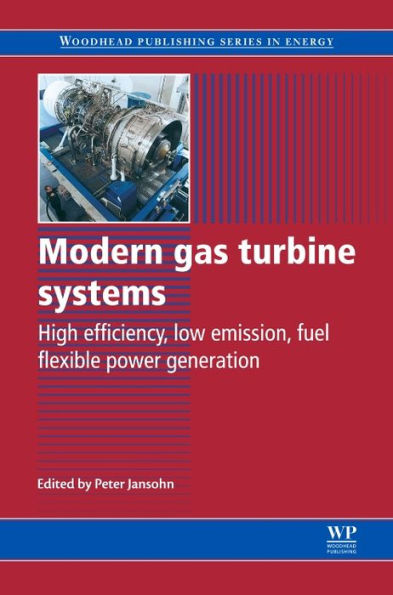Modern gas turbine power plants represent one of the most efficient and economic conventional power generation technologies suitable for large-scale and smaller scale applications. Alongside this, gas turbine systems operate with low emissions and are more flexible in their operational characteristics than other large-scale generation units such as steam cycle plants. Gas turbines are unrivalled in their superior power density (power-to-weight) and are thus the prime choice for industrial applications where size and weight matter the most. Developments in the field look to improve on this performance, aiming at higher efficiency generation, lower emission systems and more fuel-flexible operation to utilise lower-grade gases, liquid fuels, and gasified solid fuels/biomass. Modern gas turbine systems provides a comprehensive review of gas turbine science and engineering.The first part of the book provides an overview of gas turbine types, applications and cycles. Part two moves on to explore major components of modern gas turbine systems including compressors, combustors and turbogenerators. Finally, the operation and maintenance of modern gas turbine systems is discussed in part three. The section includes chapters on performance issues and modelling, the maintenance and repair of components and fuel flexibility.Modern gas turbine systems is a technical resource for power plant operators, industrial engineers working with gas turbine power plants and researchers, scientists and students interested in the field. - Provides a comprehensive review of gas turbine systems and fundamentals of a cycle - Examines the major components of modern systems, including compressors, combustors and turbines - Discusses the operation and maintenance of component parts
1111318344
Modern Gas Turbine Systems: High Efficiency, Low Emission, Fuel Flexible Power Generation
Modern gas turbine power plants represent one of the most efficient and economic conventional power generation technologies suitable for large-scale and smaller scale applications. Alongside this, gas turbine systems operate with low emissions and are more flexible in their operational characteristics than other large-scale generation units such as steam cycle plants. Gas turbines are unrivalled in their superior power density (power-to-weight) and are thus the prime choice for industrial applications where size and weight matter the most. Developments in the field look to improve on this performance, aiming at higher efficiency generation, lower emission systems and more fuel-flexible operation to utilise lower-grade gases, liquid fuels, and gasified solid fuels/biomass. Modern gas turbine systems provides a comprehensive review of gas turbine science and engineering.The first part of the book provides an overview of gas turbine types, applications and cycles. Part two moves on to explore major components of modern gas turbine systems including compressors, combustors and turbogenerators. Finally, the operation and maintenance of modern gas turbine systems is discussed in part three. The section includes chapters on performance issues and modelling, the maintenance and repair of components and fuel flexibility.Modern gas turbine systems is a technical resource for power plant operators, industrial engineers working with gas turbine power plants and researchers, scientists and students interested in the field. - Provides a comprehensive review of gas turbine systems and fundamentals of a cycle - Examines the major components of modern systems, including compressors, combustors and turbines - Discusses the operation and maintenance of component parts
345.0
In Stock
5
1

Modern Gas Turbine Systems: High Efficiency, Low Emission, Fuel Flexible Power Generation
838
Modern Gas Turbine Systems: High Efficiency, Low Emission, Fuel Flexible Power Generation
838Related collections and offers
345.0
In Stock

Product Details
| ISBN-13: | 9780857096067 |
|---|---|
| Publisher: | Woodhead Publishing, Limited |
| Publication date: | 08/31/2013 |
| Series: | Woodhead Publishing Series in Energy |
| Sold by: | Barnes & Noble |
| Format: | eBook |
| Pages: | 838 |
| File size: | 23 MB |
| Note: | This product may take a few minutes to download. |
About the Author
From the B&N Reads Blog
